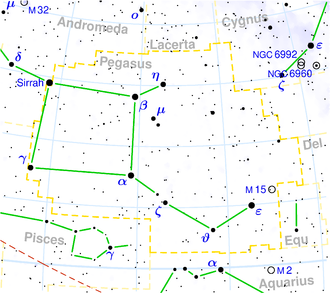NGC 7784
| Galaxie NGC 7784 | |
|---|---|
 | |
| SDSS-Aufnahme | |
| AladinLite | |
| Sternbild | Pegasus |
| Position Äquinoktium: J2000.0, Epoche: J2000.0 | |
| Rektaszension | 23h 55m 13,7s[1] |
| Deklination | +21° 45′ 44″[1] |
| Erscheinungsbild | |
| Morphologischer Typ | C[1][2] |
| Helligkeit (visuell) | 14,5 mag[2] |
| Helligkeit (B-Band) | 15,5 mag[2] |
| Winkelausdehnung | 0.50 × 0.5[2] |
| Flächenhelligkeit | 12,8 mag/arcmin²[2] |
| Physikalische Daten | |
| Rotverschiebung | 0.026185 ±0.000110[1] |
| Radialgeschwindigkeit | (7850 ±33) km/s[1] |
| Hubbledistanz vrad / H0 | (358 ± 25) · 106 Lj (109,8 ± 7,7) Mpc [1] |
| Geschichte | |
| Entdeckung | Édouard Stephan |
| Entdeckungsdatum | 1. Oktober 1883 |
| Katalogbezeichnungen | |
| NGC 7784 • PGC 72862 • CGCG 477-029 • MCG +04-01-001 • 2MASX J23551365+2145438 • GALEXASC J235513.51+214545.1 | |
NGC 7784 ist eine kompakte Galaxie vom Hubble-Typ C im Sternbild Pegasus am Nordsternhimmel. Sie ist schätzungsweise 358 Millionen Lichtjahre von der Milchstraße entfernt und hat einen Durchmesser von etwa 50.000 Lj.
Im selben Himmelsareal befindet sich u. a. die Galaxie NGC 7786.
Das Objekt wurde am 1. Oktober 1883 von dem französischen Astronomen Édouard Stephan entdeckt.[3]
Weblinks
Einzelnachweise
Auf dieser Seite verwendete Medien
Autor/Urheber: Sloan Digital Sky Survey, Lizenz: CC BY 4.0
The sky image is obtained by Sloan Digital Sky Survey, DR14 with SciServer.
Angle of view: 4' × 4' (0.3" per pixel), north is up.
Details on the image processing pipeline: https://www.sdss.org/dr14/imaging/jpg-images-on-skyserver/



